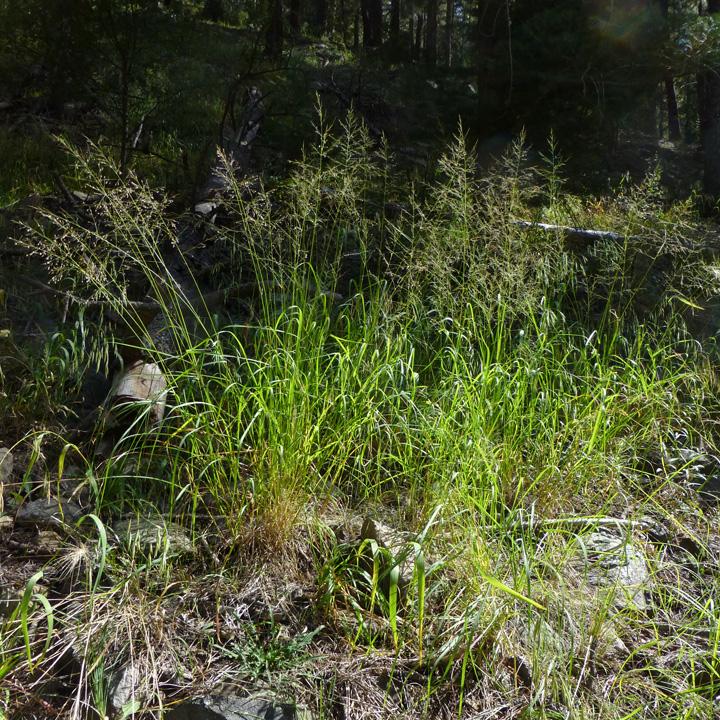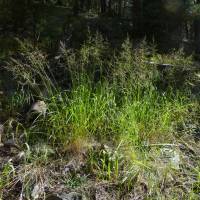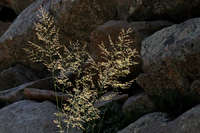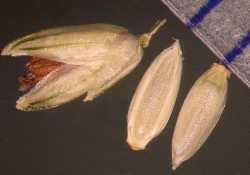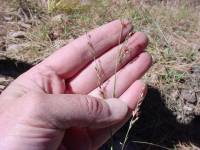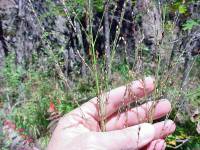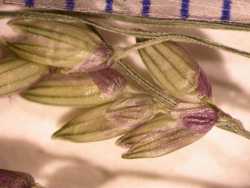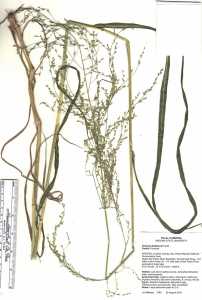Culms 20-200 cm tall, 1-8 mm thick, erect or geniculate at the lower nodes; nodes glabrous or pilose; internodes glabrous. Sheaths shorter than the internodes, keeled, glabrous or pilose, hairs near the throat papillose-based; ligules with a 0.1-2 mm membranous base and 0.10–3 mm ciliate fringe; blades (6)20-75 cm long, 1.5–15 mm wide. Panicles 9-75 cm long, width to about 2/3 length; branches straight or flexible, strongly ascending to reflexed; pedicels 0.2-5 mm. Spikelets 2.5-5.5 mm long, 1-2 mm wide. Lower glumes 1.2-3.5 mm, 1/2-4/5 as long as the spikelets, 3-5-veined; upper glumes 1.4–4 mm; lower florets sterile or staminate; lower lemmas 2.9–3.3 mm; upper florets 2.1–5 mm long, 1-1.5 mm wide, lemma apices puberulent. 2n = 36, 54, 70, 72.
Zuloagaea bulbosa grows in roadside ditches, on gravelly river banks and moist mountain slopes, often in ponderosa pine and oak woodlands, from southern Nevada and Arizona to western Texas and central Mexico. It is considered an important forage grass and is sometimes cut for hay but is not known to be cultivated. Flowering is from July to mid-October.
In the past, three species have been recognized within Panicum sect. Bulbosum. Bess et al. (2006) demonstrated that the variation is continuous and highly influenced by environment. Their recommendation, that Hopia be treated as a unispecific genus, is followed here. Plants growing in sunlight tend to have purple spikelets, those growing in the shade tend to have green spikelets.
Common Name: bulb panicgrass
Duration: Perennial
Nativity: Native
Lifeform: Graminoid
General: Tufted perennial grass, 20-200 cm tall, from short knotty rhizomes; stems slender, 1-8 mm thick, erect or geniculate, with bulbous cormlike swellings at the base; nodes glabrous or pilose.
Vegetative: Sheaths shorter than the internodes, keeled, with papillose-based hairs near the throat; blades 20-75 cm long, 1.5-15 mm wide, flat; ligule a fringe of hairs, more or less connate and membranous at base.
Inflorescence: Pyramidal panicle 9-75 cm long, width to about two thirds length; branches straight or flexible; lower branches strongly ascending to reflexed; spikelets 3-5 mm long, 1-2 mm wide, 2-flowered, the first floret reduced to a sterile lemma and the second floret fertile; lower glume one third to two thirds as long as the spikelet, 3-5 veined; upper glume glabrous; fertile lemma indurate, finely rugose, mostly about 3 mm long, tapering to a point or a short stout beak.
Ecology: Found on moist slopes, along gravely river banks, in canyons and along roads, from 4,000-8,000 ft (1219-2438 m); flowers July-October.
Distribution: s NV and AZ to w TX; south to c MEX.
Notes: The genus Panicum is defined as having unawned spikelets with 2 florets, the first floret sterile or staminate, and the second floret bisexual with a rigid lemma that clasps the palea. This species has all those traits and was formerly identified as Panicum bulbosum; however, molecular phylogenetic studies consistently place the species within the bristle clade of Paniceae, with Setaria, Pennisetum, and Cenchrus. It was given its own genus within that clade, in order to maintain monophyly within Panicum. The species is easy to identify by its open loose pyramidal panicle, which has a delicate purple tinge when growing in the sun, and the bulbs at the base of the stems. Panicum antidotale is another rhizomatous perennial, but it has a more densely flowered panicle, often has stouter stems, and lacks the bulbs at the base of the stems.
Ethnobotany: Seeds were winnowed, ground, and made into flour, which was used for bread and to thicken gravy.
Etymology: Panicum is a classical Latin name for millet, while bulbosum means bearing a bulb, referring to the cormlike bases of the stems.
Synonyms: Panicum bulbosum, P. bulbosum var. minor, P. plenum
Editor: SBuckley 2010, AHazelton 2015


